

Mexican American Psychology: Social, Cultural and Clinical Perspectives
MA Tovar – 2017 – books.google.com
There are now more than 32 million Mexican Americans living in the United States. As a
result, the odds that a clinician will work with a member of this population—one of the fastest-
growing minority groups in the United States—is extremely high. Understanding the culture…
Link to book preview
Alt.Latino Explores Afro-Latin Music For Black History Month
“I think there is this reclaiming of Afro-Latinidad through culture and through music. And one of the examples I think of is “Africana” by Los Rakas. Los Rakas is an Afro-Panamanian group based out of the Bay Area. They have this fusion called Panabay where they mix Caribbean sounds with hip-hop. And “Africana” is an ode to black women and their beauty…”
Link to conversation
Esther Cepeda: Latino health-outreach program is a reminder that it’s all in the name
If culture can be used as a currency to understand and serve a community, it can also be a trap, if the culture is painted with too broad a brush. We think we “know” the so-called Hispanic community — generalizing to certain tropes about language, love of family, deference to authority figures, etc. — and we rarely stop to question whether our initial assessments still hold true.
For instance, a decade ago, the hot medical news was the emerging use of “promotoras” — Spanish-speaking Latina community volunteers who worked with medical organizations to coordinate health outreach activities in their neighborhoods — as a cutting-edge tactic to produce better outcomes in predominantly Mexican populations suffering from obesity, diabetes and other ailments…
Link to article
Latino Protestants in America: Growing and Diverse
MT Mulder, AI Ramos, G Martí – 2017 – books.google.com
Latino Protestantism is growing rapidly in the United States. Researchers estimate that by
2030 half of all Latinos in America will be Protestant. This remarkable growth is not just
about numbers. The rise of Latino Protestants will impact the changing nature of American…
Link to book excerpt
Ethnic Humor in a Multicultural Society
L Gogová – Ars Aeterna, 2016
… 22 yellow.” The Mexican child says, “When the phone greens, I pink it up and say yellow.” The
joke is an example of ethnic humour, which uses a minority ethnic group (in this case
Hispanic/Latino Americans) as a target and the aspect of linguistic imperfection as a pivot in …
Link to article PDF
New Campaign Launched to Increase Latino Representation and Impact Across Greater Boston: Press Release
BOSTON, MA – The Greater Boston Latino Network (GBLN) today launched a new campaign to increase Latino representation and impact in local government, which will include digital outreach, discussion forums and the release of a new report.
“Latinos are the region’s fastest growing population, contributing billions to our local economy and tax base, but we are largely absent from decision-making positions,” said GBLN Steering Committee Member Alex Oliver-Dávila. “This campaign will help increase the voice, impact and representation of Latinos across Greater Boston.”…
Link to article
MABPA: Mexican American Business and Professional Association
Mission
MABPA: Prioritizing access, advocacy and prosperity for all San Diego Communities.
MABPA’s robust membership actualizes its mission with an informed focus on Business, Education, Community Leadership, and the Legislative domain…
Link to web site
International Friendships:The Interpersonal Basis of a World Wide Community
A GARCIA – International Friendships: The Interpersonal Basis of a …, 2016
… American migrants is greater in the United States, in recent years, some publications shed further
information about Latin Americans in Canada … In 2013, approximately 11.6 million Mexican
immigrants lived in the United States, compared to 2.2 million in 1980, representing…
Link to book preview
Hispanic Female-Owned Businesses On The Rise In Arizona
At about 8 o’clock on a recent Tuesday night, 36 small-business owners were working their second shift of the day at the Fuerza Local business accelerator.
The six-month-long program is for Spanish-speaking business-owners and is run by the Local First Arizona Foundation. The program trains small-business owners on the ins and outs of starting and running a business, from finances and budgeting to planning for growth, according to Edgar Olivo, the director of the program.
At the end of the program, each business will receive $1,000 to invest in their growth…
Link to article
WeHo’s John Duran Elected Chair of Latino Elected Officials Group
NALEO today announced the election of Duran as chair of its board and of two new members on the 15-member board. They are Jessica Herrera-Flanigan, executive vice president of government and corporate affairs at Univision Communications Inc. and Joseph “Pep” Valdes, executive vice president and director of new business development for Parking Company of America…
Link to article
New mayor seeks cooperation, also higher developer fees
Developers with projects in the pipeline can expect to be asked to provide more affordable housing and a stronger community benefits package before being approved, Mayor-elect Jesse Arreguín said Monday during a far-ranging interview with Berkeleyside.
Now that the self-described progressives have the City Council majority (see below for more details) the “previous approach” to development will change, he said.
“I do think the voters wanted a change,”Arreguín said at PIQ on Shattuck Avenue. “That’s one of the reasons I was elected by such a large margin. One of the issues I heard throughout the city of Berkeley was a concern about the major demographic changes, the changes to the character of the place, long-time businesses being displaced, the scale of development.”
“I think the voters of Berkeley want more equitable, responsible growth,” he said. “That is not to say everything is going to come to a grinding halt. We need to create more housing so, certainly, under my administration, we are going to encourage the construction of transit-oriented development in Berkeley.”…
Link to article
Mixtec Evangelicals
Many miles away from the popular Mexican seaside resort towns of Puerto Vallarta and Cabo San Lucas lie the poor, rural villages of Mexico’s Mixtec people, also known as “the People of the Land of the Rain.”
The Mixtecs originally developed communities isolated by the hilly Oaxacan terrain, with many remote villages accessible only on foot. The arrival of Spanish colonizers in the 1500s brought Catholicism to these communities, and it became a major force — both religious…
Link to article
Mexican American Proarchive: Annual Report on Mexican American Professionals
News from the census American Community Survey is generally good for the 2015 year. Mexican American college enrollment was up from 18.7% to 18.9% in the 2014 and 2015 years. Graduate or professional degree attainment was also up from 2.9% to 3.0%. The number of bachelor’s degrees granted to Mexican American students rose from 7.6% in 2014 to 7.8% in 2015.


In spite of these gains, Mexican Americans still remain at the bottom of the ladder when it comes to earning a bachelor’s degree. Even after broadening the group to Latinos or Hispanics, this group still lags behind. According to the Pew Hispanic Center: “As of 2014, among Hispanics ages 25 to 29, just 15% of Hispanics have a bachelor’s degree or higher. By comparison, among the same age group, about 41% of whites have a bachelor’s degree or higher (as do 22% of blacks and 63% of Asians).” Pew reports that the main reasons for this low graduation rate is that Hispanics are less likely “to enroll in a four-year college, attend an academically selective college and enroll full-time.”
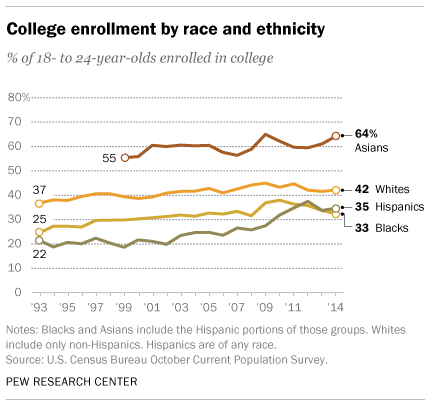
Also in the good news column, the University of California will continue to push for a greater number of underrepresented minorities; namely, Chicano/Latino students whose resident freshmen numbers rose from 2.7% to 32.3% of admitted California freshmen. In other good news, the proportion of Chicano/Latino students transferring from community colleges increased to 29.3% from 26.8% for 2015.
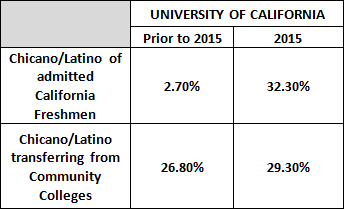
Occupations, including those in management, business, science, and art, fared better for Mexican Americans. The number of Mexican Americans filling these occupations rose from 17.4% in 2014 to 17.5% in 2015.

The total number of Hispanics filling these occupations was 16.1% in 2015, a bit lower than Mexican Americans specifically.
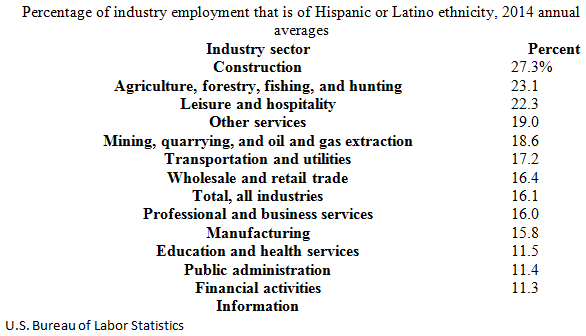
The report shows that industrial employment for Mexican Americans remained the same for 2014 and 2015 at 10.2%.
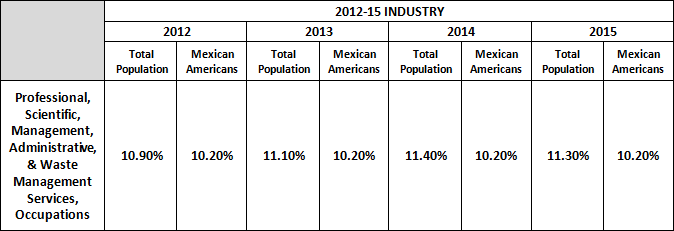
The figures for Hispanic or Latino employment for 2015 and 2016 show a healthy increase.
According to the Pew Hispanic center, “Construction, professional and business services, health services, financial services and food services…showed healthy gains.” Most of the jobs gained by native-born Hispanic workers were in manufacturing, mostly durable goods (82,000 Hispanic workers in this industry), followed by wholesale and retail trade (79,000), publishing, broadcasting, communication and information services (55,000), and construction (54,000).
Foreign-born Hispanics had the most job gains in construction (417,000), followed by business and professional services (179,000). Together, those two industries accounted for almost three-quarters (74%) of all jobs gained by foreign-born Latinos between 2005 and 2006.
The business and professional services sector, which ranges from management and technical services to janitorial, landscaping, and waste management services, is also a key employer for non-Hispanic workers. Of the total increase in employment in 2005-06, non-Hispanic workers accounted for 410,000 employees in the industry, native-born workers 327,000, and foreign-born workers 83,000.
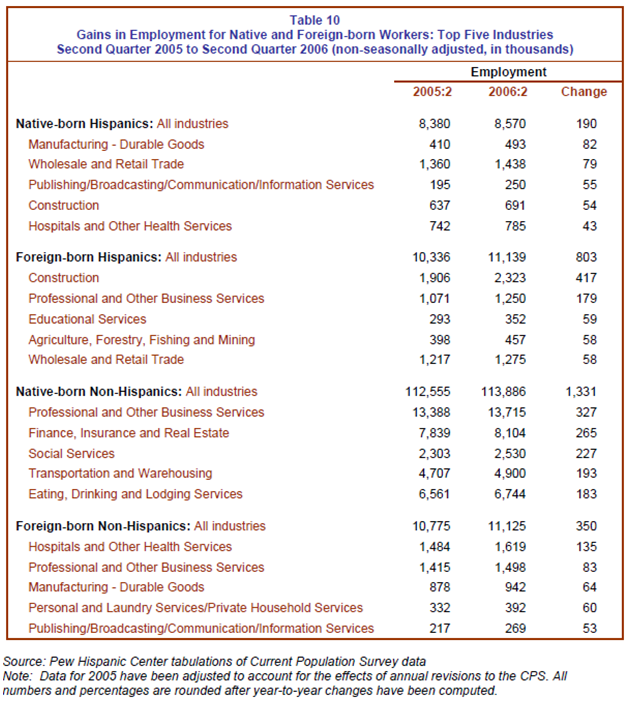
Sources
- Census Bureau, Selected Population Profile in the United States: 2015
- Pew Research Center
- University of California
- Bureau of Labor Statistics
Obama White House Touts Latino Gains in Income, Education, Health
by SUZANNE GAMBOA
WASHINGTON, DC — The White House on Wednesday touted gains Hispanics have made in education, income and health insurance during President Barack Obama’s time in office.
In a report released to mark the closing days of Hispanic Heritage Month, which ends Saturday, the White House issued a four-page brief from its Council on Economic Advisers on the Hispanics’ economic progress in the Obama years.
Obama marked the close of Hispanic Heritage month with remarks at a White House reception Wednesday afternoon. Hispanic Heritage Month began Sept. 15 and closes on Saturday.
“Over the last eight years we have made a lot of progress, together for all Americans and nowhere have you been able to see more vividly the progress than in the Hispanic American community,” Obama said at the event…
Link to article
USC professor spotlights the significance of Latinos to California’s future
The USC Price School of Public Policy has taken a leading role in training local decision-makers and its partnership with the Latino Caucus demonstrates the inroads it has made.
That’s a thought from USC Price Professor Raphael Bostic.
USC Price hosted more than 20 public officials from the League of California Cities Latino Caucus, who took part in the Bedrosian Center on Governance’s Local Leaders Executive Education Forum on Sept. 22 and 23.
The participants, many of whom are mayors or council members of cities across California, heard presentations from USC Price faculty on leadership, public ethics and housing policy, among other topics.
Professor Frank Zerunyan, director of executive education at the Bedrosian Center, led the program, which was the product of an agreement that USC Price and the Bedrosian Center signed with the Latino Caucus in 2014 to provide training aimed at enhancing the leadership capacity of public officials statewide…
Link to article
Statistical Portrait of Hispanics in the United States
There were 55.3 million Hispanics in the United States in 2014, comprising 17.3% of the total U.S. population. In 1980, with a population of 14.8 million, Hispanics made up just 6.5% of the total U.S. population. Read the accompanying report, “The Nation’s Latino Population Is Defined by Its Youth.”…
Link to article
Raciolinguistics” How Language Shapes our Ideas about Race
AF Ball – 2016
… Gordon, University of Arizona 3. From Mock Spanish to Inverted Spanglish: Language Ideologies
and the Racialization of Mexican and Puerto … University of South Carolina 5.“Suddenly Faced
with a Chinese Village”: The Linguistic Racialization of Asian Americans 97 adrienne …
Link to book preview
Annual New Mexico Hispanic Fiesta Draws Native American Ire
It’s a week-long event that draws together generations of northern New Mexico Hispanic residents, some who can trace their roots to the 1600s.
For centuries, northern New Mexico Hispanic residents have held an elaborate festival in Santa Fe to honor Spanish conquistador Don Diego De Vargas, who reclaimed the city following an American Indian revolt. There is music, dancing, a parade and the reenactment of De Vargas’s “peaceful reoccupation” of what is now New Mexico’s capital…
Link to article
Nationally Recognized Scholar of Latino Politics to Speak at CSU, Chico for Constitution Day 2016
Dr. Gary Segura of Stanford University will make the California State University, Chico Constitution Day keynote address, “The Future is Ours: How Demographic Change and Latino Voters Are Changing American Politics in 2016 and Beyond.” The event is on Tuesday, September 20 at 6 p.m. in the Bell Memorial Union auditorium. It is a free, public event open to all students, faculty and community members.
Gary Segura is the Morris M. Doyle Centennial Professor of Public Policy at Stanford University. He is the director of the Stanford Institute on the Politics of Inequality, Race and Ethnicity, and a fellow of the American Academy of Arts and Sciences. His work focuses on issues of political representation and social cleavages, the domestic politics of wartime public opinion, and the politics of America’s growing Latino population…
Link to article
‘I’m Latino and I Don’t Speak Spanish’: Young Men Talk About Identity
Am I Hispanic enough? Am I American enough? This is the dilemma that many Latinos face at some point in their lives, whether they are 1st or 5th generation.
Part of this is the tension in answering people’s assumptions, expectations and yes, stereotypes that exist about what “constitutes” a Hispanic. And these assumptions come from both inside and outside the Latino community.
We spoke to three young men who have different upbringings and unique backgrounds. Yet they have one trait in common: their love for their roots, and their candor at some of the challenges they have while trying to explain their cultural identities…
Link to article


